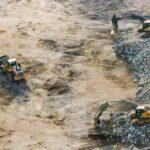Fire Threat Intensifies as Spot Fires Erupt in Barragga Bay
Residents Urged to Remain Vigilant
As the extreme weather conditions continue to fuel the flames of the Coolagolite bushfire in the Bega Valley area of New South Wales, firefighting crews and residents alike are bracing themselves for a long and challenging battle ahead. The fire, which has already burned more than 5,100 hectares, has predominantly spread in a south-easterly direction, but a southerly change expected overnight could change the trajectory of the blaze.
The NSW Rural Fire Service (RFS) has stated that the threat to Bermagui has eased for the time being, but residents are advised to remain vigilant as conditions could worsen with the southerly change. Spot fires, caused by embers being blown long distances ahead of the main fire front, have already ignited in Wapengo and Barragga Bay, which means that homes in these areas are at particular risk.
Evacuation and Emergency Measures
Those in the impacted region who do not feel adequately prepared to defend their properties have been strongly advised to consider relocating to safer places such as Bega or Narooma. Two evacuation centres have been established in each town to accommodate those seeking shelter. Meanwhile, the Bermagui Lifesaving Centre has been deemed unsafe, and the Bega Showgrounds and the Narooma Leisure Centre have been designated as official evacuation centres.
The NSW RFS has also closed several roads in the affected areas due to the fire danger, and power has been lost in Cobargo, Brogo, and other surrounding areas. Essential Energy crews have been working tirelessly to restore power to impacted homes and businesses.
Emergency Communication and Assistance
The Australian Red Cross has launched the Register.Find.Reunite service, which allows those affected by the Coolagolite bushfire to connect with their families and friends. This service aims to alleviate the stress and anxiety caused by being separated from loved ones during an emergency. People can register and search for others through the online service using their computer or mobile device.
It’s crucial for residents and visitors in the impacted areas to stay informed and use all available modes of communication to receive updates and warnings. Radio, social media, and other sources should be utilized, especially since downed powerlines have impacted communication efforts in the area.
Analysis and Advice
The Philosophy of Firefighting
Fire has always been a primal force, both destructive and regenerative. As wildfires continue to ravage vast areas of Australia, it raises profound questions about our relationship with nature and how we manage these devastating events.
The philosophy of firefighting is deeply rooted in the understanding that fire is a natural part of the Australian landscape. Indigenous cultures have long recognized the importance of controlled burns for land management and biodiversity. However, climate change and human activity have intensified the severity and frequency of wildfires, challenging our ability to control them.
Climate Change and Fire Emergencies
The current bushfire crisis serves as a stark reminder of the urgent need to address the underlying issue of climate change. Rising temperatures, drying vegetation, and increased periods of drought are all contributing factors to the heightened fire danger in Australia.
While firefighting efforts are crucial in the short term, it is essential that we also focus on long-term solutions to mitigate the impacts of climate change. This includes reducing greenhouse gas emissions, transitioning to renewable energy sources, and implementing sustainable land management practices.
Community Preparedness and Response
In the face of wildfires, preparedness and community resilience are key factors in minimizing the impact on lives and property. Residents in fire-prone areas must have robust bushfire survival plans, including knowing evacuation routes, establishing communication networks, and preparing their properties to withstand potential threats.
Government agencies, such as the NSW RFS, play a critical role in providing information and support during emergencies. However, it is also the responsibility of individuals to stay informed, follow official instructions, and prioritize their safety and the safety of others.
The Need for Adaptability and Collaboration
As the threat of wildfires becomes more prevalent, it is crucial for communities, governments, and emergency services to adapt and collaborate effectively. This includes investing in infrastructure, such as fire-resistant buildings and early warning systems, as well as fostering partnerships between various agencies and organizations.
Furthermore, it is important to acknowledge and learn from the Indigenous communities who have successfully coexisted with fire for thousands of years. Their traditional knowledge and practices can provide valuable insights into managing and living with the ever-present threat of wildfires.
Editorial
Addressing the Root Cause
While the Coolagolite bushfire is a current concern, it is just one of many fires occurring across Australia. It is essential that we address the root cause of these devastating events. Climate change is not a distant future problem; it is here and now, and its impacts are being felt profoundly in our country.
As a nation, we must prioritize climate action and commit to reducing our carbon emissions. This requires significant policy changes, investment in renewable energy, and a collective effort from all sectors of society. Failure to address climate change will result in more frequent and intense wildfires, putting lives, livelihoods, and ecosystems at risk.
Conclusion
The Coolagolite bushfire serves as a reminder of the ongoing threat of wildfires in Australia. While the immediate focus is on firefighting and protecting lives and property, we must also address the underlying causes of these disasters. Climate change and human activity must be urgently addressed to mitigate the future impacts of wildfires.
At the same time, community preparedness and resilience are crucial in ensuring the safety of individuals and minimizing the damage caused by fires. Collaboration, adaptability, and learning from Indigenous wisdom are essential elements in effectively managing the ever-present threat of wildfires. Only through collective action and a comprehensive approach can we hope to build a future where the destructive power of fire is minimized, and our relationship with nature is harmonious.

<< photo by Connor McManus >>
The image is for illustrative purposes only and does not depict the actual situation.
You might want to read !
- Gippsland in Flames: Homes Devoured by Relentless Fires
- Fury in the Flames: Rebuilding Resilience in the Wake of Victoria’s Devastating Fires
- “Paradise Lost: The Heartbreaking Farewell of the Saunders Family”
- “Miraculous Discovery: 9-Year-Old Charlotte Sena Reunited in Perfect Condition!”
- Afghan War Survivor’s Journey: From Taliban-Ruled Afghanistan to Washington’s Tribulations
- Australia’s Political Landscape Unveiled: Weekly Insights from Teneo
- “Kitchen Catastrophes: The Controversial Exits from My Kitchen Rules”
- Fireworks at the North London Derby: Arsenal 2-2 Tottenham – A Premier League Showdown to Remember
- “The Ultimate Guide to NRL Grand Final 2023: Unveiling the Essentials and Insights”
- Rock ‘n’ Roll Ritual: AFL Grand Final Entertainment Goes All Out with a Spectacular KISS Show
- Crikey! Magpie Mania Strikes Melbourne, Shaking up the City
- NRL superstar left reeling in chaotic mass brawl: An alarming display of violence on the field




